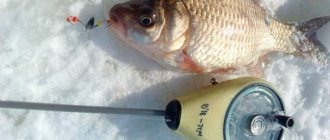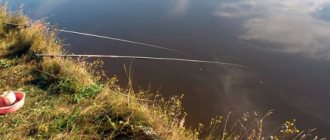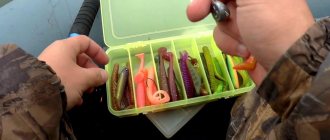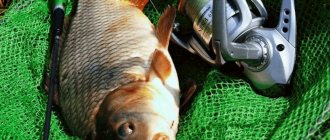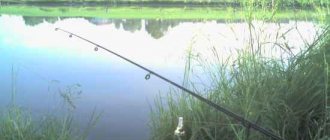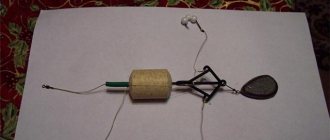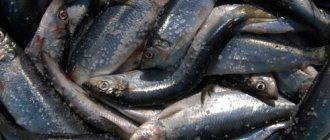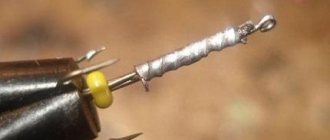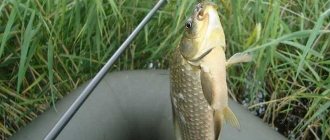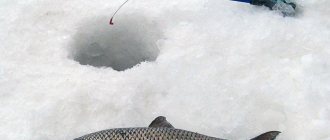The term “perfect” best suits good winter sports equipment.
For, from my point of view, in no other fishing is the perfection of the components of the tackle as important as in ice fishing. The number of these very parts in a winter fishing rod is minimal (compared to a sports float or spinning rod), the criteria for perfection (of course, as for sports) are known, and the cost is relatively affordable. It is necessary, of course, to take into account that the main goal of sports gear is to catch the maximum amount (weight) of fish from a given section of a reservoir in a limited period of time. That is, to paraphrase V. Lenin, “more is better, yes... different.” Can sports gear be in demand for recreational fishing? Undoubtedly. First of all, in “busy”, popular places. Many times I had to observe how the owners of giant “ants” and a fishing line with a diameter of 0.1 mm sat without biting, while the miniature “tungsten” and a fishing line with a diameter of 0.07-0.08 bit well. And even if you are incredibly lucky and have the opportunity to regularly catch humpback perch in completely deserted places, I am sure that sports experience in equipping a fishing rod for ice fishing will be useful even for amateur fishing. I'm not even talking about amateur fishermen who want to try their hand at fishing.
Imperfection of gear is one of the stumbling blocks that harshly “breaks off” many. Of course, perfect tackle is not sufficient, but only a necessary condition for successful performance. Other conditions include technique, tactics, and good physical preparation. I hope the material will answer most of the questions novice winter sportsmen have regarding tackle, will help make the sport of fishing even more widespread and prepare a worthy successor to the Ukrainians, the current world champions in sports jig fishing.
Jigs
The material is tungsten, preferably chiseled and not powdered. The fact is that hard and extremely refractory tungsten is difficult to process, so there are many tungsten jigs on the market made by powder metallurgy. But their density is lower than the density of metal tungsten (19.3 g/cm) due to the presence of a binder between the tungsten particles, the density of which is much lower than the density of pure, or, as materials scientists say, compact tungsten. As a result, the bodies of some (by no means all) powdered tungsten jigs have a density comparable to that of lead jigs (about 11.5 g/cm). Such jigs lack the main advantage of tungsten jigs - miniature size with sufficient weight. Jigs made of gold are in definite demand among athletes. In terms of cost, finished products are only slightly more expensive than tungsten ones - the higher cost of gold is compensated by the ease of its processing.
Form
Form. In sport fishing with a jig, in 90% of cases, jigs of two forms are used - a droplet and a shot. The pellet is usually used when fishing for roach, silver bream and ruffe by moving it at the bottom and smoothly lowering/rising it. The teardrop is a more universal form. Basically, jigs of this shape are used for high-frequency play when catching perch, but they are also good when catching other fish.
The color of the jig has a certain effect on the number of bites. Among athletes, there are two colors in use - pure unpainted tungsten metal and coated with a layer of matte copper. It is believed that copper-coated jigs are more attractive when fishing for white fish, as well as in sunny weather, while unpainted tungsten ones are more attractive for catching perch and in cloudy weather. Jigs in gold and silver colors are less commonly used.
Hooks
The second nuance of the “correct” jig is the “correct” hook. The quality of manufacture of the hook itself (shape, wire thickness, strength, sharpness of the sting, even color), as well as the length of the forearm, matter. Hooks with a longer shank are better at hooking fish, but are more noticeable. Hooks made of thick wire for sports jigs are generally unacceptable, since they are clearly visible, tear small and medium-sized bloodworms, and also penetrate worse into the tissues of the fish’s mouth when hooking. Some models of hooks Maver, Kamasan, Mustad have satisfactory quality. By the way, about bloodworms: all winter sportsmen hook something edible, and in 99% of cases it is ruby, the freshest natural product, and not some tasteless cambric. Moreover, almost everyone uses bait, but this is a topic for a separate article. Have you touched on the topic? Now we quickly return to the materiel, having intrigued the reader...
Hole for fishing line
Hole for fishing line. All “correct” tungsten sports jigs must have a hole in the body for a fishing line of a minimum diameter, always protected by the same tasteless cambric.
Every extra tenth of a millimeter in the diameter of the hole takes away the mass (but not the size) of the jig. The absence of a cambric in the hole of a tungsten jig (even with special tying of the jig, countersinking of holes, etc.) inevitably leads to sudden cutting when playing the “eleventh” fish. Therefore, tungsten jigs that are not equipped with a cambric (and there are many of them) need to be modified .
A plastic tube of minimum diameter is made as follows. The insulation from the low-current wire is removed from the core and, holding it with two fingers, it is slightly heated over the flame of a lighter, and then stretched. The result is a “mustache”, part of which is most likely suitable for equipping the thinnest hole. The “whisker” is threaded into the hole in the body of the jig until it is fixed in it, after which the tails are cut off flush.
I use the so-called Tula jigs - turned, with a sharp hook made of the finest wire and a hole of minimal diameter (naturally, protected by cambric). Unfortunately, they almost never go on sale. These masterpieces are relatively expensive even without store markups, and not every amateur fisherman needs some of the best jigs in the world. On the other hand, the author of these lines deliberately paid so much attention to the characteristics of “correct sports” jigs. It is possible that tomorrow some artel or SPD will start producing similar products in significant quantities and at reasonable prices. There are more than a dozen such manufacturers in the CIS, and the crisis and competition, I hope, will force them to produce high-quality products.
Among the folk gears, droplets with an eye are of satisfactory quality. Due to the absence of a hole in the body of the jig (it is replaced by a hook loop, which does not cut the line and for which a cambric is not needed), it was possible to maintain an acceptable density of the material, the hooks, although a bit thick, are of high quality (Kamasan), and the silver color looks very attractive to fishermen , and for fish.
Winter fishing with a sports jig
When the arsenal of equipment for participation in the competition is carefully prepared, they think about how to effectively use their winter fishing experience, and take into account the mistakes made in previous competitions and training. It is important to anticipate what kind of jigs and attachments fishing will require from you these days, and what types of bait will be effective.
Ice fishing competitions usually last three days. The first day is devoted to training the athletes, familiarizing them with the features of the reservoir and the fish living in it. The competition itself is held over the next two days in two rounds. On an unfamiliar body of water, a winter sports jig requires certain tactics from the athlete, allowing him to quickly realize his best fishing qualities.
Participants study the reservoir in advance, the behavior of the fish, and its preferred types of gear. This information is obtained from the Internet or by communicating with amateur fishermen who visit this body of water.
Fishing tactics
Participation in the competition begins by measuring the depths of the designated area for the upcoming fishing. Study the responsiveness of fish to various baits, select suitable baits. On the first training day, the competition organizers designate the ice zones where the athletes will compete. A winter sports jig without the athlete’s tactics worked out in advance does not bring a catch.
If teams compete, then ice drilling on the training day is carried out in an organized manner, making a series of holes along the border of the designated area. The distance between them should not exceed 10 meters. From the very first hole, fishing rods with jigs about 3 mm in diameter with bloodworm attachments are put out for test fishing. After making up to 10 retrieves in each hole, move on, looking for fish. When all the holes have been completed with a winter jig fishing rod, you need to throw bait into those of them where there were bites. Professionals use bloodworms for this.
Having made a circle with a test fishing rod along the drilled holes, you should measure the depths, recording the results in a notebook. If there were no bites, the circle must be repeated, and those holes where there was a bite should be marked on the drawn diagram of the competition area. Then experiment with the available gear, moving from smaller to larger ones.
Having identified which of them the fish bite better, do not stop the preparatory work, proceed to bait. First, feeding is carried out in different holes in portions of different sizes, this allows you to determine the optimal amount of food needed to keep the fish at the hole without overfeeding.
The listed tactical points are the basis for successful participation in the competition. When fishing as a team, get together after a day of training and share your observations. This will allow you to develop the basic tactics for participating in the competition.
Perch fishing
Experts consider perch to be one of the most athletic fish species. These predators often bring victories in competitions. Small perch live in almost every body of water. It goes well with roach, ruffe, bream, even pike. Perch is responsive to bloodworm baits; its activity is high in flowing reservoirs, where it remains throughout the winter.
Nowadays, under-ice sports perch jigs are popular. When training on perch, you can successfully practice the technique and tactics of behavior for the upcoming fishing competition.
Perch is partial to any form of jig, but when fishing for it, athletes prefer the following types:
- ball;
- drop;
- oatmeal.
The smaller the size of the gear, the less important is its shape. The catchers are those that are made with hooks of medium forearm length. Perch is attracted to the game of bright objects with shine. But he does not refuse the bloodworm bait lying on the muddy bottom. Winter jig fishing is especially good in those reservoirs where large perch are found in abundance. It is also capable of quickly rising upward with constant feeding directly from the ice.
Roach fishing
Do not invent special equipment for catching roach; a sports fishing rod for winter fishing for this fish is no different from equipment for catching other inhabitants of the reservoir, such as perch and bream. A short rod for roach has a sensitive nod, and a suitable attachment is suspended at the end of the fishing line. Its size and thickness of the fishing line depend on the depth from which the fish are supposed to be caught. More often, jigs are made of tungsten with a diameter of about 3 mm, and fishing line is used with a diameter of about 0.1 mm.
Fishing with a jig begins with choosing a fishing method. Unlike perch, roach does not like fast movements; playing with the bait should be smooth. Techniques such as tapping the bait on the bottom are effective in competitions, because roach prefers to take the bait close to the ground. The resulting cloudy cloud attracts this fish.
More often, bites occur during an upward movement; they are distinguished by their clarity. If there are no bites at the bottom, you should move on to playing near the ice itself. The game should be with stops and breaks, this is important when the roach bite is not active.
Often sport fishing for roach is successful with the bait standing still. Then the fisherman can hold the fishing rod securely enough. Since the bites of this fish are short-lived, have time to hook in time.
fishing line
In order not to go into philosophizing, I will immediately name the best (from my point of view) fishing line on the Ukrainian market - this is Sunline. The working diameter of the fishing line is 0.06-0.08 mm . A thinner line is inconvenient due to increased “stickiness”, which forces you to handle it with increased care, which, in turn, wastes precious seconds. Shimano fishing lines (Ultegra, Silk Shock and Frog Hair) are of satisfactory quality. It is not advisable to purchase cheaper fishing lines - two reels of 50 m each are enough for the sports season, and the fishing line, especially thin ones, must be changed every year due to the inevitable decrease in strength as a result of aging. To my regret (and probably to the delight of sellers), manufacturers do not indicate the date of manufacture on spools of fishing line, although they could make an exception for expensive and thin fishing lines (as well as fiery athletes).
Nod
Nods for sports jigs are made of lavsan film 0.15-0.25 mm thick. Of the commercially available ones, 0.2 mm thick nods made in Russia are of satisfactory quality.
Suitable ready-made sports nods, except for the hole for the fishing line, do not have any loops or rings in the working part, only their thin part is painted in a bright color. For attachment to the whip, a combination of insulation is usually provided for wires of various thicknesses. I am giving a detailed description for the same reason as for jigs - several organizations and home craftsmen are engaged in the production of nods, and it is possible that last season’s favorites will not appear on sale or their quality will be lost, and new craftsmen will finally master the production of perfect nods. In the meantime, many athletes make their own nods, cutting them out of lavsan film. This has its own logic - you can make a unique product that suits your personal skills and needs. On the other hand, for example, it is difficult for me to make several nods that are absolutely identical in characteristics.
As a result, if the jig breaks and the fishing rod is replaced, it takes some time to adapt, which, in principle, is wrong.
How to make a sports jig with your own hands
The choice of jigs in fishing stores is large, but professionals prefer to make them themselves. Intuition and experience tell the fisherman subtleties of appearance that industrialists cannot notice.
Various technological methods are used to make homemade gear:
- casting;
- soldering;
- production using metalworking tools.
It is difficult to make something from tungsten at home, since this material is refractory and has great strength. But tin and lead are soft, fusible materials for making attachments, which have long been favored by homemade athletes.
Manufacturing process
A simple way is to solder according to your finished form. Take fishhooks, a soldering iron and a piece of tin, drop the resulting melt one by one into molds prepared in advance with hooks embedded in them. The resulting products do not always have a correct and attractive geometry, which makes them more similar to living bugs and spiders.
An aluminum casting mold can be made by hand or purchased from an experienced mechanic. A hook is placed in it and molten lead or tin is poured into it. You can make the mold yourself, for example, from plaster or liquid glass. But these materials are not durable. However, the homemade shape reflects the look that the fisherman wants to implement in the bait.
Actually the fishing rod
The traditional “balalaika” is our everything. You can buy fishing rods, modify them a little, and go out to the “battle on the ice.” The modification consists of treating with fine-grained sandpaper the internal surfaces of the foam handle in contact with the reel, and the reel itself, as well as the plastic axis. It is necessary to achieve smooth rotation. For smooth rotation and braking, you can place a washer cut from the same Mylar film under the plastic nut and spool. In addition, it is advisable to widen and equip with a cambric the hole for the passage of fishing line in the body of the fishing rod, as well as slightly sharpen the whip of the fishing rod - for greater flexibility. Some go even further - they grind off part of the body, with the goal of making the fishing rod as light as possible, or even make this device to order. In general, a sports winter fishing rod must meet the following requirements - fit comfortably in the hand, perfectly absorb the jerks of the fish (the fishing line is quite thin), the reel must rotate easily and not freeze in any weather conditions, and, if necessary, be slowed down with the necessary controlled force with a nut. Do not allow the reel to get jammed or the fishing line to get between the reel and the fishing rod body . On ice, this inevitably leads to loss of time and is fraught with line breakage.
Fishing rods for jigs
Let's assume that the angler has already tried fishing with a jig, using standard fishing rods on a riser, and decided to take the active game more seriously. To do this, we set up that we will need several tackles, about a dozen, pre-balanced at home - for different weights of jigs, respectively, with selected nods and line thicknesses. Therefore, you need to buy 5-10 fishing rods at once.
You should pay attention to special jig fishing rods - lightweight winter balalaikas. Fishing stores and online stores now sell everything you need for this. Specialized sports winter fishing rods for jigs are the best option. Such fishing rods are a little more expensive (100-300 rubles), however, they are worth it. Such fishing rods were originally designed for game fishing with jigs. However, such gear is not always easy to obtain. Sometimes you need to do some serious shopping or surf the Internet in search of the right option.
Yaroslavl balalaika, US-4 Tri Kita and HFB-22
The Master Sportivnaya winter jig fishing rod was developed by the famous sports fisherman Evgeny Chabutkin from Yaroslavl. The tackle is popular among athletes and amateurs. Light weight (11 grams) and size (thickness 6 mm), simplicity. There are no special bells and whistles - the design is simply made exactly as needed for jig fishing. The fishing rod has been verified by the creator’s many years of competition experience. The cost of the product is about 300 rubles. Cheaper analogues - Three whales of the US-4 Sportivnaya and Chinese replicas (for example, Rosy Down or HFB-22). These products are no worse than the Yaroslavl ancestor, but many times cheaper.
Master Chabutkina
HFB-22
US-4 Sports
Ivanovo balalaika
A similar product is a sports balalaika from Mastiv for 100 rubles. The designs and dimensions are similar. The body is made of hard foam. Thus, the coil is built into a foam casing. This is both an advantage and a disadvantage. Light weight and “warmth” of the material for the hands against fragility. This fishing rod requires careful handling.
Sports (Ivanovo)
killer whale
The Killer Fishing Rod from Crazy Brothers is also specially designed for game jig fishing. The special curve of the body may be convenient for anglers. Light weight, smooth rotation of the reel, overall lightness and simplicity.
killer whale
These three balalaikas are considered the best winter fishing rods for jig fishing. These tackles are also suitable for reelless fishing without a nod, if you replace the whip with a thin carbon one. The light weight of the tackle as a whole allows you to feel bites in your hand and give the game the desired high-frequency character. You need to understand that it is better not to leave such fishing rods unattended in the riser hole - even a small roach will pull such a light structure under the water.
Lure
Contrary to popular misconceptions, bait is actively used in sport fishing. Small bloodworms, large bloodworms, as well as dry mixtures based on plant components (Sensas, VDE...) are usually used in this capacity. The bait is used sparingly. As a rule, a pinch of small bloodworms or 8-15 pieces of large ones, a few teaspoons of pre-moistened dry mixture, are thrown into the hole. If the depth of the pond is greater than 22.5 m, it may be advisable to place the bait in the feeder and then open it some distance from the bottom. This is done to prevent the fish from “rising” from the bottom, and also to prevent “smearing” of the bait.
Ice screw
Swedish Mora ice screws are of satisfactory quality. Out of a wide range of products, my preference was not the new Expert 110 mm model. Why her? Round knives, from my point of view, drill ice a little better than flat ones, and the diameter of 110 mm is a compromise, since I also use the same ice drill for recreational fishing. At competitions, a diameter of no more than 100 mm is desirable (the smaller the diameter, the faster and with less effort the hole is drilled, and the less “exposed” to the area under the ice), for amateur fishing it is better to have an ice drill of a larger diameter (larger prey can be caught without any problems) . As far as I know, ice screws with a diameter of less than 100 mm are not available for free sale. “Sotki”, as far as I know, is produced by the Barnaul plant and TM Rapala. I can’t judge how good these drills are, although reviews on the forums about them are generally quite good. Strictly speaking, the topic of ice screws and bait does not quite correspond to the topic of our conversation today (and the “perfect” principle), but I mentioned them in order to answer most of the questions that beginners have in one material.
In conclusion, I would like to emphasize once again: perfect tackle is 20, or maybe 25% of success. Delicate mastery of the technique of playing with a jig and catching large specimens, knowledge of the characteristics of the reservoir, tactics and positional combat, psychological attitude, physical preparation - this is, perhaps, a list of the main components of success at the ice stadium.
Author: Evgeny Gridko
